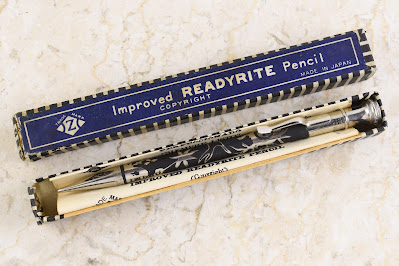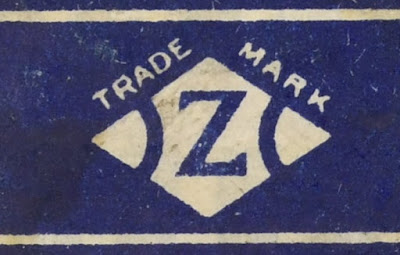This article has been included in The Leadhead's Pencil Blog Volume 7, now available here.
If you don't want the book but you enjoy the article, please consider supporting the Blog project here.
The first of these two might have slipped into my collection under false pretenses:
One of them – the silver one I think – found its way to me at the Chicago show some fifteen years or so ago, while the other was in that enormous collection I bought at the Philadelphia Show back in 2015 (the “Philadelphia Hoard,” I call it). At the top, these have an imprint I’d rate a nine or so out of ten on my coolometer:
“ReadYRite Patented,” they read, accompanied by a neat zigzag design around the crown. When I say it joined my collection under false pretenses, I mean that I assumed the ReadYRite was patented in the United States, and I assumed that eventually I would run across that patent and write up a nice story about it.
When I did run across a patent, sometime between my encounters with these two pencils, I was a disappointed to learn that the ReadYRite might violate my frequently bent-to-the-point-of-breaking rule of collecting American pencils only. It turned up on these:
The wonderful black background on this series isn’t quite niello; it feels and behaves almost like powdercoating. At the top end, these read “READYRITE / Patent No. 66805 / Made in Japan.” The patent number indicates that these were both made and patented in Japan (the number is much too low for an American patent).
Obviously, the foreign ancestry of these didn’t deter me, since I’ve picked up three of them. I told myself that I often make exceptions for foreign-made pencils actively marketed in the U.S., and these two types of pencils are so different that maybe the ReadYRite is American after all.
When a boxed example of the Japanese version showed up online, it went ‘round the horn a few times as I pondered whether it was worth the investment. When I finally took the plunge, it was in the hopes that the paperwork which accompanied it might tell a little more of the story:
I’ll admit that even if this one had absolutely nothing to do with the American pencil industry, I would eventually have caved. The pattern is really nice, and it is in perfect condition:
The box and instructions didn’t help much, containing nothing that neatly laid out the whole story at my feet. But there were a couple clues:
First is the name of the pencil – the “Improved” Readyrite. Does that mean that the ReadYRite pencils were a previous incarnation? Maybe . . . although the two pencils are so different, I can only speculate. Then there’s another interesting word . . . “copyright.”
In some European circles, the word “copyright” is sometimes used to mean “trademarked.” In this case, it must mean something else . . . the box lid and instructions also include the words “Trade Mark”:
In American Writing Instrument Trademarks 1870-1953, I find two nearly identical trademarks: the first doesn’t appear to have anything to do with either the ReadYRite or the “Readyrite”:
Aloysius J. Coleman, who provided a business address of 610 W. 139th Street, New York, claimed to have first used the trademark “Ready-Rite” on pencils and magazine pencils on September 1, 1920; his application for registration was filed February 17, 1921 and it was granted registration number 157,029 on July 25, 1922.
Note however that the mark is italicized and hyphenated, so this isn’t exactly the same as the ReadYRite and doesn’t share the same distinctive lettering. I checked American Writing Instrument Patents Vol. 2: 1911-1945 looking for other clues, and Coleman did receive a patent for a mechanical pencil - number 1,440,058, applied for on March 19, 1921 and issued December 26, 1922. However, it doesn’t look like either the ReadYRite or the Kobayashi Readyrite:
Coleman is an enigma. His address, 610 West 139th Street in New York, appears to have been residential apartments only, and I found no listing for any business there. In addition, Coleman isn’t listed in the 1920 New York City Directory, even though that’s where he said he was when he signed his trademark registration application on February 12, 1921.
The “Ready-Rite Pencil Corporation” was organized in Delaware, as announced in the Wilmington Morning News on February 21, 1921. The incorporators were only professional front men, so the real parties in interest for the new company were not revealed:
The Ready-Rite trademark was the only one Coleman succeeded in registering, but it wasn’t the only one he applied for. On April 27, 1921 he apparently hit on the idea of offering personalized pencils, and he filed trademark applications for a flurry of common first names for use on pencils. None of these were granted registration, and it’s ironic that Tom, Dick, and Harry weren’t among them:
The only suggestion that Coleman’s Ready-Rite pencils made it into circulation was an account in the Weatherford (Oklahoma) News on April 27, 1922, which reported that the local Ford dealer, Bergman & Friesen had given out several hundred “Readyrite” pencils as a promotion – there’s no hyphen in the name as reported . . . maybe that was editorial oversight, or maybe these were my ReadYRite pencils:
On August 24, 1925, Commerce Reports noted that trademarks were applied for in Japan which conflicted with American trademarks in use in Japan, including Zembei Kobayashi’s Readyrite trademark, published in Japan on May 26, 1925. Coleman apparently didn’t object, and he might have been out of the pencil business by 1925.
There was a second Readyrite trademark registered in the United States, number 268,359, was applied for on December 23, 1927 and was granted registration on March 11, 1930, to Zembei Kobayashi of Tokyo, Japan. The mark closely resembles the one found on my boxed example, and Zembei claimed to have used it since December 5, 1923. Kobayashi notes that the mark had already been registered in Japan as number 174,470 on October 7, 1925:
Incidentally, that “Z” trademark found on the box and instructions likely refers to Zembei. That mark is not listed in American Writing Instrument Trademarks 1870-1953: maybe Kobayashi carried more products than pens and pencils and the mark was filed under some other category, or maybe it was filed only in Japan or some other country.
Kobayashi’s Readyrite was offered in other English-speaking nations in addition to United States. The earliest reference I found for the pencils, “of handsome design,” was in the Adelaide (Australia) Register on October 2, 1926:
The Ogden (Utah) Standard-Examiner advertised “Improved Readyrite Pencils” on August 19, 1928:
Readyrites were offered in “nickel or gilt” in the Edmonton (Alberta) Journal on December 2, 1927:
And an advertisement in the San Francisco Examiner on September 23, 1928 offered Readyrites with “colors inlaid with silver” for 25 cents:
I was really, really, REALLY hoping that I would find evidence that Zembei Kobayashi later went into the porcelain business. The Usual Suspects is one of my all-time favorite movies, and “Mr. Kobayashi,” Keyser Soze’s shadowy agent in the film was later revealed . . . well, I don’t want to give anything away if you haven’t seen the film (do race to wherever one watches old movies and you’ll see what I mean).
Alas . . . the only references I can find to a Kobayashi Porcelain are tribute coffee mugs inspired by the movie. Apparently, “Kobayashi Porcelain” was a fictional company.
However, Zembei did leave me with another tantalizing bit of information that will have me actively tracking down other boxed examples of the Readyrite.
This paperwork indicates this was the “Blue Bird Pencil,” etched with “the symbol of all joy and happiness to the possessor.” A closer look at the barrel bears out that description:
Which leads me to wonder . . .
What were the other patterns called?























Gun/knife show find. A Readyrite mechanical pencil with 'Cutco' advertising. Mint with nice Cutco (founded in 1949) logo on clip. Made in USA. Guss I can't post a pic...
ReplyDelete